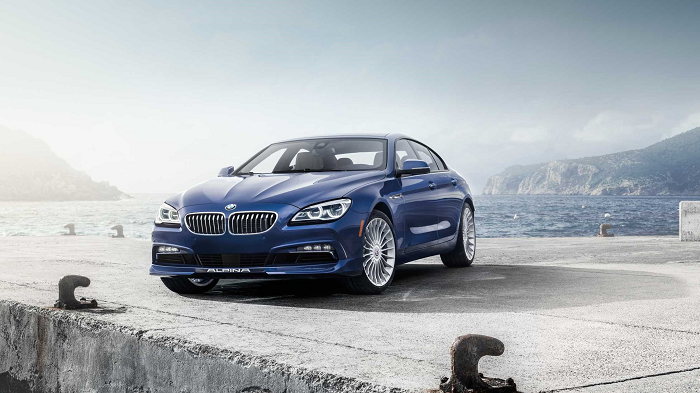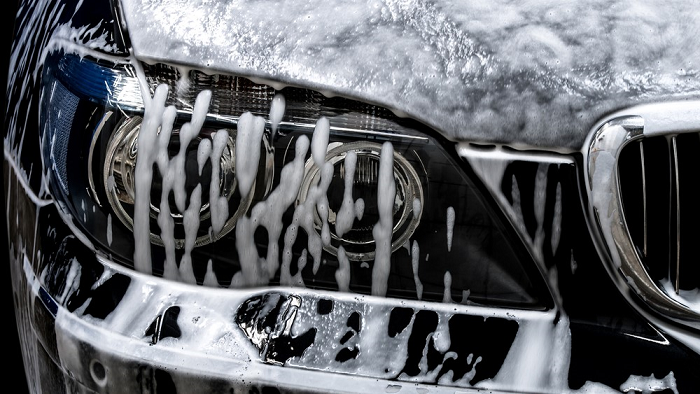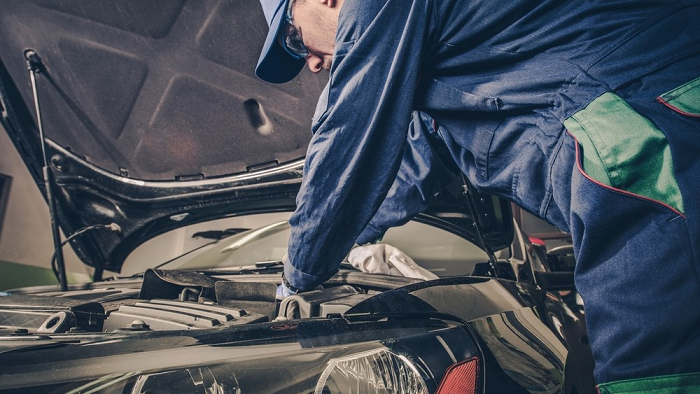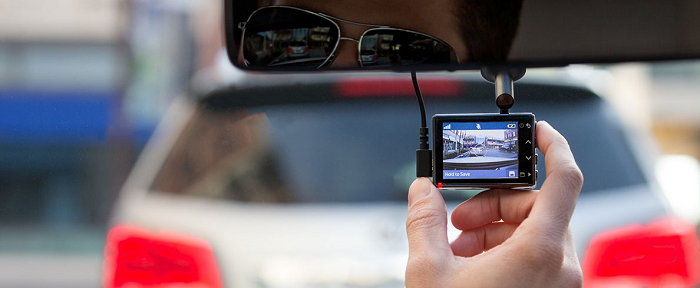Phase 5 — Living the Gentleman Spy Lifestyle
Lesson 6 — Vehicle
LESSON 6: Vehicle

You don’t have to be chasing through Rome in an Aston Martin to have a 007-worthy ride.
Make sure that whatever car you have (or choose to buy) fits your personality, does what it needs to do, is in good repair, and is always clean and neat.
Wash Regularly, Clean the Inside

Keeping your vehicle clean is one of the easiest things you can do to enhance your enjoyment of it. From your daily commute to date night or a race through the streets, keeping your vehicle clean and orderly makes life better.
Whether you pay for the service or do it yourself every weekend, you should at least:
- Wash the outside
- Pick up the trash
- Vacuum the floor
- Clean the windows (inside and out, use a glass sealant like Rain-X to improve visibility in inclement weather)
- Wipe down the inside (dash, console, door sills, clean fingerprints off display screens, etc.)
- If it stinks, use Febreze or air freshener
When talking about cleaning the inside, that also means keeping everything organized. You don't want old to-go wrappers, empty cups, receipts, or even cable clutter from your phone charger or radar detector cluttering up the inside.
If you have accessories like GPS, radar detectors, phone mounts, cell extenders, etc. mounted inside your car, think about hard-wiring them, rather than using the usual cigarette plug adapters that dangle everywhere.
If you need to keep an umbrella, pens, notepads, your laptop, GPS, tools, or anything else inside your car, keep everything organized and put away. Get a console or seat organizer and make sure that whatever you use goes back to its proper place when you're done using it.
Whether you need to pick up a date, a coworker, friends, or your mother, you should never have to clean the inside of your vehicle to make it presentable — it should already be good to go.
Normal washing and tidying up every week or two will keep it clean and fresh for a long time.
Beyond the basics, take it for a serious wash and detailing every 1–3 months depending on where you live and what kind of abuse your car takes on a regular basis. Wash, wax, and protect the exterior; clean and polish the wheels and tires; dust, vacuum, treat, and protect the interior.
Basic care will help your vehicle will look and work its best for years to come.
Maintain Your Ride

Taking care of your car is more than just changing the oil every few thousand miles.
Professional drivers and those that rely on their vehicles make use of preventative maintenance systems (PMS) to verify that everything is always in top working condition and take care of problems before they start. In many circles, like police and fire departments, these checks are done daily. Others are done on a weekly or monthly basis. Download this checklist and use it as necessary.
For your personal vehicle, check the following (print and use this checklist):
Daily (done during normal use, as you’re driving)
- Fuel: ½ tank or higher at all times
- Fill up daily if you live in an area and/or season where evacuation is likely
- Check any warning lights or messages as soon as they appear
- Rear view and side mirrors are in place and properly adjusted
- Pay attention to how your vehicle drives and constantly watch out for changes
Weekly (should take 1–2 minutes, once per week)
- All lights functioning (headlights, taillights, turn signals, brake lights)
- Windshield wipers work, have fluid, free of debris
- Windshield and windows clean and in good repair
- Clean windshield and headlights whenever you stop for fuel
- Basic walk-around eyeballing tire condition and inflation, body damage, etc.
- Horn functions properly
- Emergency brake functions properly
Monthly (should take less than 5 minutes, once per month)
- Insurance card and vehicle registration present and up to date
- If any documents expire within the next two months, renew now
- Seat belts for every passenger are in place and functional
- Fluid levels are within proper range
- Oil
- Coolant
- Transmission
- Windshield washer
- Tires are properly inflated (check with pressure gauge)
- Tires have adequate tread wear
- For those with seasonal changes, pay attention to when you rotate between summer and winter tires
- Spare tire is present and properly inflated
- Jack and tire iron are present and functional
- Fire extinguisher is present and currently serviced
- First aid kit is present and stocked
- Vehicle safety kit present and stocked
- Toll transponder is in place and has funds (call, use the app, or check online to verify balance)
- Keep $20–50 in cash in small bills and a $25 roll of quarters to pay tolls
As Needed
Consult your owner's manual or manufacturer's website for specifics. Below are ballpark recommendations:
- Change oil — every 3,000–7,500+ miles
- Consult your owner's manual or manufacturer's recommendations; 3,000 miles is generally not necessary anymore, 5,000+ miles is common for newer vehicles.
- Rotate your tires (including spare, if applicable) whenever you change your oil.
- If you live in an area that gets regular snow/ice/winter driving conditions, you should have modern, purpose-built winter tires. These will last longer and perform better in almost every winter condition than either all-season or studded tires.
- Change between summer and winter tires as necessary.
- Check your wiper blades; change as necessary (as often as every six months).
- High quality blades like the Bosch ICON or Rain-X Latitude are excellent choices when it comes time to replace factory blades; they work better and last longer than budget choices.
- Change your cabin air filter - every 12,000-20,000 miles
- Upgrading to a HEPA cabin air filter will give you better performance and protection against smoke, dust, allergens, and other contaminants.
Mileage Checkups
- 15,000 miles: oil change, air filter change, tire rotation, inspection of basic areas like brakes and cooling system
- 30,000 miles: oil change, air filter change, tire rotation, transmission fluid change (?), fuel filter change, overall vehicle inspection
- 45,000 miles: oil change, air filter change, tire rotation, transmission fluid change (if not done at 30k miles), vehicle inspection including tires, brakes, power steering, spark plugs, etc.
- 60,000 miles: oil change, air filter change, tire rotation, transmission fluid change (?), fuel filter change, replace any belts/valves/hoses that are wearing out, change spark plugs, replace brake pads and fluid, full vehicle inspection including everything from previous levels and including all engine, suspension, and HVAC components
REPEAT ABOVE SCHEDULE AS NECESSARY AND RECOMMENDED BY YOUR MANUFACTURER OR MECHANIC.
Consult your mechanic or dealer for any issues as soon as they arise; catching problems early could be the difference between a $100 seal replacement and a $6,000 rebuild.
Secure Your Vehicle

You don't need bulletproof glass, a BMW you can drive from your phone, or rocket launchers to take steps to secure your vehicle.
The vast majority of problems you're likely to face occur to your unoccupied vehicle, which also means they're the easiest to prevent:
Lock Doors and Arm Alarm (if equipped)
ALWAYS lock your doors and arm the alarm, even if you think you'll be right back to your vehicle. Unlocked vehicles make upwards of 90% of vehicle break-ins. It takes half a second to hit the lock button on your key or remote. Don't get burned because you're lazy.
Don't Leave Valuables in Plain Sight
After unlocked vehicles, leaving valuables easily visible is the next prime reason for break-ins. Phones, GPS, radar detectors, briefcases, backpacks, laptop bags, and more are all prime targets. Whether you take them with you, lock them in the console or glove box, or just push them under the seat so they're not visible, make sure that your vehicle looks empty and unattractive when unattended.
Secure Sensitive Documents and Items
Vehicle registration, insurance cards, and other documents may contain your full name, home address, and other information that could be dangerous in the wrong hands. Despite this risk you are probably required to keep these documents accessible when operating the vehicle, so take steps to secure this information. Don't leave it unlocked in the glove box for any petty thief to access.
Lock your glove box and console if possible. If you have to give your keys to valets, car wash or service personnel, use the valet key to keep these areas secure.
For added security (or if you're unable to lock the glove box), use a lockable security/deposit bag to store documents. Options also exist for safes that are permanently mounted in your vehicle like ConsoleVault. Use this if it makes in your lifestyle.
Sensitive items aren't limited to insurance, registration, or expensive accessories. The receipts, mail, and other detritus that collects inside your vehicle provides clues to your habits, movements, and lifestyle that could be used against you if compromised. Gather, clean, or throw all this away regularly.
Garage door openers represent an additional security risk. If your garage door opener is unsecured, when somebody opens your car they now have access to your garage and possibly your entire home if you don’t lock the door between your garage and interior. If your car is broken into while you’re away from home, thieves could have access to your home address, all kinds of personal information, and your home. From simple burglaries to home invasions, attacks, or kidnapping or ransom attempts, this is a dangerous scenario.
Replace your garage door opener with a version that fits on your key chain, secure it in your [locked] console or glove box, or even program the garage door opener in your vehicle if it has one. Whatever you do, do not leave a garage door opener unsecured in your vehicle.
No Bumper Stickers
Bumper stickers, vanity plates, and special license plate covers are problematic no matter how you look at them. They make you and your vehicle more memorable and recognizable and they broadcast your opinions, affiliations, or personal information for everybody to see.
Information commonly available via bumper stickers includes: weapons availability (gun related and/or conservative/libertarian), family situation (baby on board, school, or stick figure family), affluence (luxury brand advertisements, private school, employer), and much more.
On top of existing dangers, advertising your political leanings on bumper stickers is an increasingly bad idea in today's hyper-polarized environment. Reports of assistance being denied to stranded motorists, road rage, and cars being smashed and burned in protests — simply because of bumper stickers for one political candidate or another — are becoming commonplace.
Don't put yourself, your family, or your property in danger because you can't keep your opinions to yourself.
Park in Your Garage
Parking in your garage does two things: it makes it harder to access your vehicle in the first place and it helps obscure your movements, making it more difficult for bad guys to know when you're home or not. This protects both your vehicle and your home in one simple step, so if you can park in your garage, do so.
The above steps are easy mindset changes that go a long way to make your vehicle — and everything you keep in it — more secure.
Locking your doors and keeping valuables out of sight removes most risk of your vehicle being a "target of opportunity." You may still be at risk of a targeted attack, but even this is diminished with the basic precautions above.

Next up are the inexpensive security measures that go a long way — tinted windows and security film:
Tinted Windows
Tinted windows represent "security through obscurity" by helping to conceal whatever you have in your vehicle. From privacy to keeping the interior cooler on hot days, window tint is almost never a bad investment, but check your local laws: regulations concerning window tint vary greatly, and getting harassed by the police because your tint is too dark is a poor trade-off.
Be smart about the tint you apply — even if it is legal to have almost blacked-out windows and windshields, this presents a safety hazard by obscuring your vision too much at night. Dark rear windows may be fine, but do not put very dark or metallic tint on the windshield and front windows.
Some tint is good. Too much is stupid and dangerous.
Security and Protection Film
Installing security film on all vehicle glass and paint protection film on the rest of the body will go a long way towards making your vehicle more secure from most everyday threats.
Security film (possibly integrated with window tint) adheres to the glass making it much more difficult to gain access to your vehicle. When hit, the window will still break, but the glass is held together and in place with the film.
Paint protection film helps protect the body and paint from everyday wear and tear, normal driving hazards like rocks kicked up on the road and minor scratches, and malicious threats like vandals, protestors, or road rage.
Adding security film and tint to your car adds a lot of physical security for comparatively little cost. Just a few hundred dollars of upgrades will make you much more secure than you would be in a stock vehicle.
Unless you face specific, exotic threats or have money to burn, the mindset changes and inexpensive upgrades above will put you in a better security posture than the vast majority of the population, as well as keeping your vehicle more comfortable and better looking, for longer.
Depending on your lifestyle, security needs, and income, you can go further:
Grille Guards, Bumpers, Front-end Replacements
For those that drive trucks and large SUV's, another excellent option are grille guards and/or replacement bumpers.
Aftermarket bumpers or grille guards greatly enhance the already superior protection offered by driving a large vehicle. There's a reason that ARB, Ranch Hand, and Road Armor bumpers dominate the trucks that the military/defense contractors take overseas and that farmers and ranchers drive every day.
Whether it's protection from animals in the road, getting in a collision, a mounting platform for lights and winches, or having to ram through a road block, heavy duty steel bumpers are a useful and stylish upgrade to your truck.
"Executive/Road Rage" Protection Packages
Overkill for many people, these packages offer substantial protection for comparatively little cost ($5–20k to upgrade your existing ride, versus $100k+ for fully armored vehicles). Options may include low-level ballistic glass and body panels inserts, run-flat tires, or tech like dash cameras, electrified door handles, and more.
These packages offer substantial protection from all but the most determined attackers while remaining an "affordable" option for those with discretionary income. If you can afford a new luxury vehicle, you can afford enhanced protection.
If offered at this price point, ballistic protection here is limited to small caliber handgun rounds. This offers extreme protection from car-jacking, getting stuck in a protest, road rage, vandalism, break-ins, etc. without the substantial cost of advanced ballistic protection against rifles or IED's.
If you decide to spend money on a protection package, weight that expenditure towards real protection like armor, evidence recorder (dash-cam), and run-flat tires, rather than gimmicky crap like electrified handles, smoke screen, road tacks, etc.
Full Ballistic Protection Packages
This is not necessary or advisable for most people in the developed world, but armored vehicles are common among the upper classes in Africa, the Middle East, and South America where organized crime, gang violence, and kidnappings are common.
If you need — and can afford — full ballistic armoring, you must seek specialized advice from the companies that produce armored vehicles like International Armoring Corporation, INKAS, Texas Armoring Corporation, Alpha Armouring, etc.
Full armor packages usually start in the $80–100k+ range, on top of the price of the vehicle. It's common for complete up-armored vehicles to cost $200–500k+ and include night vision systems, ramming bumpers, self-sealing fuel tanks, deadbolt door locks, siren/loudspeaker systems, smoke screen, tire spikes, CBRN air filter systems, etc.
NOTE: Advanced protection packages, while fun to think about, are well past the point of diminishing returns for most people. If you live the kind of life where dropping $100k on upgrades to your car is an everyday expense, go for it. On the other hand, if you feel like you need to have a fully armored vehicle, a better choice is almost certainly to spend that same money to move to an area where your life isn't under that kind of threat.
As with everything else in the program, start with the basics and work your way up:
- Get in the habit of always locking your doors
- Don't leave valuables in plain sight (especially electronics like phones, GPS, radar detectors, etc.)
- Secure sensitive documents
- Remove all possible bumper stickers
- Park in a garage if possible
- Install security and protection film
From there, you can upgrade as your needs and finances allow.
Safety Technology

From accident or traffic jam warning systems to radar detectors, laser jammers, dash cams, or CB radios, there is technology you can add to your vehicle to make your driving safer and/or more efficient.
None of this is required. You can drive safely as long as you like without any of this. But if you want an extra layer of protection in the event of an accident, from police radar, speed or red-light cameras, or just want to be able to reroute around traffic jams, adding some or all of this tech can make life easier.
The free Waze smartphone app features navigation coupled with user-generated alerts to speed traps, accidents, road hazards, traffic jams, the cheapest gas stations, and more — this is a must for road trips.
If you're using a connected Escort radar detector, the Escort Live app might be a better option.
Standalone radar detectors can be incredibly useful and should be thought of as required equipment if you regularly drive over the speed limit, but you can't really skimp here: either buy one of the below units, or don't bother at all. There is no in between.
- The Escort Max 360c or Max360 are the best full-featured windshield mount radar/laser detectors with features like directional arrows, GPS support, databases of red light or speed camera locations, learning features to reduce false alarms, and Wi-Fi (on the 360c) for ease of updating. One of these two should be your default choice unless you're a serious enthusiast or want a much more expensive system.
- The Uniden R3 offers better all-out range and excellent performance but doesn't offer the "user friendliness" or directional capability (important) of the Escorts.
- Windshield mount detectors are good, but they do have their drawbacks. You either risk them being a target for thieves, or take them down and set them up every time you want to use them (pro-tip: use a BlendMount instead of the suction cups that go on your windshield).
- For the best performance and ease of use, a discreetly installed unit like the Escort Max 360 CI is the best option. It offers the best overall performance while staying completely stealth to radar detector detectors if you drive through areas where radar detectors are illegal like Virginia or Washington, D.C.. This is available as a standalone detector, coupled with Escort's laser jammers (good), or paired with AL Priority's laser jammers (best) for the ultimate protection against police radar and laser systems.
A laser jammer (always coupled with a radar detector) will give you more protection to avoid a ticket and points on your license.
- The Escort Max CI 360 is the most user-friendly "all in one" option. You get an excellent radar detector and good laser jammer in an easy to use system that, especially when combined with the Escort Live app, offers great performance in an easy to use, professionally installed system.
- Another option is to couple the Escort Max 360c with an Escort ZR5 or ZW5 laser jammer. It's not as slick as a discreetly installed system but is just as functional and much less expensive.
- AL Priority is "the professional's laser jammer." It's available as a standalone jammer, but you should couple it with ALP's NetRadar option (good) or the Escort Max 360 CI (Escort for the best radar detection, ALP for the best laser jamming). For the enthusiast, this offers the best laser jamming performance and top-tier radar detecting performance, at the cost of slightly more setup and user engagement required than the Escort systems.
WARNING: in the United States, radar detectors are legal everywhere except in Virginia and Washington, D.C., but laser jammers are illegal in 10 states and many countries worldwide — do your research and make informed decisions.
GPS devices feature navigation, plus optional dash cameras, databases of speed and red-light cameras, attractions, gas stations, and more. These may not be as necessary in the age of smartphones, but they do have a one huge benefit: they work whether or not you have cell service.
Dash-cams offer security and peace of mind from myriad threats as well as entertainment value by being able to record driving adventures, accidents, near-misses, police encounters, or just funny stuff that happens on the road.
CB radios used to be a common sight on highways; now they're mostly used by tractor-trailers and off-road vehicles. Because of their use by truckers, they can be valuable for road-trippers looking to evade speed traps, gather more information about the roads ahead of you, get help if you break down or get stuck, or just for fun.
These technical additions won't necessarily make you a safer driver, but they can go a long way towards reducing risk in many scenarios. If you're a city driver who rarely speeds, you may not need or want any of them. If you're looking to set the new Cannonball Run record, you need all of these and more. If you don't speed but might otherwise attract unwanted attention, a dash cam may give you peace of mind and usable evidence in case bad things happen. You could use all of them, or none, depending on your driving style, location, needs, and budget.
Be Ready for the Unexpected

Life happens, to you and other people:
Jump start a friend's vehicle.
Flat tires.
Running out of gas.
Medical emergency.
Stranded or can't get home.
Having an emergency kit will mean the difference between a minor inconvenience and a true disaster.
If you don't already have a basic vehicle safety kit, you need to set one up.
At the most basic, you must be able to fix or change a flat tire, jump start a car, treat minor medical issues like cuts and scrapes, and take care of the other odds and ends you're likely to encounter.
A good starting point is to keep at least the following in your vehicle:
- Cell phone charger with appropriate cables for your phone and those of your closest friends or family. This is easy in the age of smartphones: get one USB adapter with Lightning, micro-USB, and USB-C connectors to cover all likely bases.
- Emergency phone numbers on a laminated card. If your cell phone dies, you need to be able to access any necessary phone numbers you're likely to need. This may be a short list with your spouse and kids only, or more comprehensive with business partners, attorneys, doctors, accountants, veterinarians, specialists, schools, or other folks you could need to get in touch with in an emergency.
- ICE (In Case of Emergency) card with relevant medical information for each family member.
- AAA card or similar roadside assistance program. This may be included with your insurance or new vehicle purchase/lease.
- First aid kit. At the minimum, you need basic first aid supplies. A trauma kit is a good idea, depending on your lifestyle, level of training, and available space. If you have special needs, make sure you're ready for that as well: Epi-Pen, AED, oxygen, insulin and/or glucose, prescription medications, spare eyeglasses, could be necessary depending on your situation.
- Jumper cables. Long, heavy gauge cables give you the most options. A jump-start pack is an excellent option but it does not replace keeping regular jumper cables in your vehicle.
- Warning signals. Commercial vehicle safety kits usually only include one triangle or flare, which isn't enough; get 3 or more lights, triangles, or flares.
- Flat tire supplies:
- Spare tire, properly inflated. The undersized donut your vehicle might have come with is better than nothing, but it's a poor substitute for a full size spare.
- Jack: the scissor jack you (should) already have is fine for most uses. If you want to upgrade, a bottle jack (for most cars) or a Hi-Lift jack (for off road use) are good choices.
- Tire iron: Make sure you have the proper size for your vehicle, plus any special keys needed for wheel locks.
- Tire gauge.
- Tire sealant: a can of Fix-A-Flat works as a basic fix to get you to a service station. A tire patch kit and compressor are good ideas if you need a more comprehensive fix, or get all of the above.
- Water. Keep at least one gallon in your vehicle at all times. More is better.
Going just a bit further to round out your options:
- Fire extinguisher. Dry chemical extinguishers are inexpensive and common. Halotron is more expensive but much less destructive and easier to clean if you have to use it.
- Multi-tool. Leatherman or similar.
- Duct tape, zip ties, and bailing wire.
- Tow strap and anything needed to attach it to your vehicle: shackles, hitch mount shackle, etc.
- Gloves. Mechanix or leather work gloves and/or nitrile gloves.
- Poncho or other rain wear. It's a good idea to have at least 2 ponchos and/or rain jackets so you and a significant other, partner, or friend can both work in the rain without getting soaked.
- Food. Some kind of non-perishable food in case you're really stuck for hours or days. Energy bars, granola, and trail mix are good choices.
The above list will take care of most basic needs. If you have special environmental concerns like very cold winters, very hot summers, or natural disasters like earthquakes, tornadoes, hurricanes, or snow storms, make sure you're ready for them as well:
- Blanket, shovel, ice scraper, salt, and warm clothes if you have to deal with cold winters.
- Water, shovel, sunscreen, a lightweight long sleeve shirt, and wide brim hat if you could get stuck in the desert.
- General survival gear like a water filter, survival blanket, N95 respirators, or other situation dependent equipment.
- Personal supplies and niceties like toiletries, hand sanitizer, baby wipes, toilet paper, Kleenex, and feminine products for your significant other.
Your safety kit might range from the most basic kit above if you only drive short distances in urban environments, to very elaborate environment-specific survival kits with water, food, signaling, survival, shelter and comfort supplies that could last multiple people for days.
Download the Vehicle Safety Kit Checklist for a comprehensive list of what to include in your emergency kit.
PROGRAM
DOWNLOADS
 Vehicle Maintenance Checklist
Vehicle Maintenance ChecklistA well-maintained vehicle looks better, feels better, and drives better. Use this checklist to keep on top of everything you need to do to keep your ride in top condition.
 Vehicle Safety Kit Checklist
Vehicle Safety Kit ChecklistBeing a good driver is more than being able to drive fast or safe. A properly stocked vehicle safety kit makes you an asset to everybody on the road and keeps you ready for anything life can throw at you.
In the next lesson...
Living like a Gentleman Spy means world travel. Get your passport(s), documents, luggage, and mindset ready to see the world.
